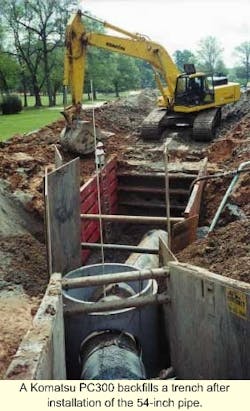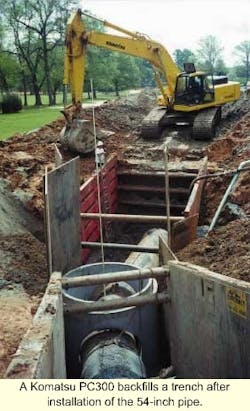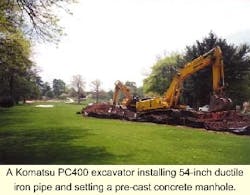Stormwater Management: Value Engineering Cuts Sewer Project Costs
Greg Harris and Monte Beasley
Atlanta, like a growing list of municipalities across the nation, is engaged in a Herculean effort to separate its existing combined waste and storm water systems. Driving this undertaking are a population explosion and tightening limits on sanitary and storm water overflows.
The Peachtree Creek Interceptor Relief Sewer is an integral part of the city's comprehensive sewer overflow abatement program. The project, originally estimated at $6.5 million, is also an excellent example of the benefits that value engineering can bring to a job. The city and the project contractor, W.L. Hailey and Company, were able to shave months off of a tight construction schedule and save thousands of dollars by performing a value engineering analysis. That examination and other strategic decisions have helped to minimize the impact of construction on homeowners, motorists, businesses and the environment.
Project Overview
The Peachtree Creek Interceptor Relief Sewer project is located between two of Atlanta's most prominent neighborhoods, Brookwood Hills and Ansley Park, and near the bustling business districts of Buckhead and Lennox.
The project called for the instillation of over 7,000 linear feet of 54-inch ductile iron pipe through the neighborhoods as well as surrounding business properties. The project is anticipated to increase the capacity of the system by 50 percent.
Originally, construction of the new line was to start in the Brookwood Hills neighborhood. From the planned shaft, a tunnel would cross beneath a nearby industrial park, Interstate 85 and the MARTA line (Atlanta's public transit system). From the tunnel's stopping point, the line would then cross 3,000 feet of the Ansley Golf and Country Club. Pipe would be placed in this part of the project by using open-cut excavation instead of tunneling. A third phase of the project involved the construction of an inverted siphon under Peachtree Creek.
Value Engineering
Value engineering is a team-oriented approach that examines construction projects and related potential challenges. This method brings together diverse professionals that can analyze a problem and develop solutions that can reduce costs and maintain or improve upon quality.
After performing a value engineering analysis of the Peachtree Creek project, W.L. Hailey suggested an alternative to sinking the tunnel shaft at the proposed Brookwood Hills site. Locating the shaft in the neighborhood would require the removal of a number of mature trees and construction of a new access road. It would also delay the project so that crews would be excavating the country club golf course in the middle of summer. This is an extremely busy time for the club and one of the most difficult times of the year to grow new grass.
W.L. Hailey recommended that the entry shaft be moved to a vacant lot near the Armor Drive Industrial Park, which is located on the outskirts of the Ansley Park neighborhood. Repositioning the shaft saved existing trees and eliminated the need for a new road because the Armor Drive location already had suitable access.
In addition, the new site would allow W.L. Hailey to begin its tunneling with a tunnel boring machine (TBM). This equipment drives tunnels much faster than hand mining, which would have been used if the shaft location had remained in Brookwood Hills. Use of the boring machine accelerated the tunneling portion of the Peachtree project. This enabled construction crews to begin (and complete) the open excavation on the golf course earlier than initially planned. This allowed for grass to be replanted and grow in time for the busy summer season.
Once the decision to move the shaft was made, W.L. Hailey began the 1,650-foot tunnel that would hold the new sewer. The company selected ductile iron pipe supplied by American Cast Iron Pipe Company.
Crews mined the tunnel in two directions: a 400-foot section went toward the Brookwood Hills neighborhood and 1,250-foot segment ran beneath the industrial park, Interstate 85 and the MARTA lines toward the golf course. This large portion of the project was complicated because crews had to install the new line without interrupting the industrial tenants, affecting daily commuters on the interstate or those riding MARTA.
An additional challenge was encountered as the tunnel approached Brookwood Hills. Crews ran into "mixed-face conditions." Mixed-face conditions include different types of rock, soil or other materials. Special hand mining equipment was needed to complete this section. If W.L. Hailey had encountered mixed-face conditions when starting the tunnel, as planned, it would have required significantly more time to complete.
A Tight Fit
One of the most challenging aspects of the Peachtree Creek project was the installation of the sewer line through the Ansley Golf and Country Club within a narrow, 50-foot-wide easement that the city purchased from the club. W.L. Hailey excavated the approximate 15-foot-deep trench using a CAT 365 and backfilled it with a PC 300. This work was done within club guidelines that required all equipment and excavated debris to remain within the easement.
Keeping the project within the easement and meeting the aggressive schedule required careful planning and close supervision of the project. W.L. Hailey project managers met consistently with country club and city officials to communicate progress.
Crossing the Creek
The final phase of the sewer interceptor project required constructing a new line across Peachtree Creek. To do this, W.L. Hailey built an inverted siphon to take the line from one bank to the other.
An inverted siphon is used when the level of a new line is higher than the bottom of the creek or river. Concrete junction boxes were built on each side of Peachtree Creek. The sewer line was brought into one box. Operating on a gravity system, the pressure from the delivery line forces the wastewater through two smaller diameter pipes that run below the bed of the creek from one box to the other. On the opposite bank, a pump takes the flow from the two smaller lines and channels it into a newly installed large diameter pipe.
Hailey used open cut construction to install the lines beneath the bed of the creek. In order to run the new lines, Hailey constructed a coffer dam to channel the water away from the excavated area while the new lines were being placed.
A challenge in constructing the inverted siphon was working within stringent environmental regulations. Georgia has strict guidelines that require contractors to monitor turbidity levels above and below the site during construction, and take precautions to minimize erosion.
Electronic monitoring systems were placed at intervals along the creek bank to track turbidity levels and ensure they were within permissible levels. In addition, staff monitored the creek bank for erosion caused by the construction.
Wet weather conditions and heavy machine traffic made bank stabilization difficult. However, consistent supervision by W.L. Hailey for signs of increased turbidity and for any early signs of erosion enabled the company to spot potential trouble areas and remediate them before they became problematic.
Conclusion
The Peachtree Creek Interceptor Relief Sewer project is a key part of an overall program that will benefit the quality of life in Atlanta by increasing the capacity of its sewer systems and helping the city meet state and federal regulatory guidelines. The use of value engineering principals and other key construction choices enabled this project to be completed ahead of schedule and within budget. It is a strong example of how municipalities are working in innovative ways with contractors to meet the growing infrastructure demands of citizens and businesses.
About the Authors:
Greg Harris is Division Manager for W.L. Hailey & Company's Atlanta division. He is responsible for all construction operations, work acquisitions, and business development in the Atlanta Region. Monte Beasley is a Senior Estimator for W.L. Hailey & Company's Atlanta division. He is responsible for estimating, value engineering and assists in construction operations in the Atlanta Region.


